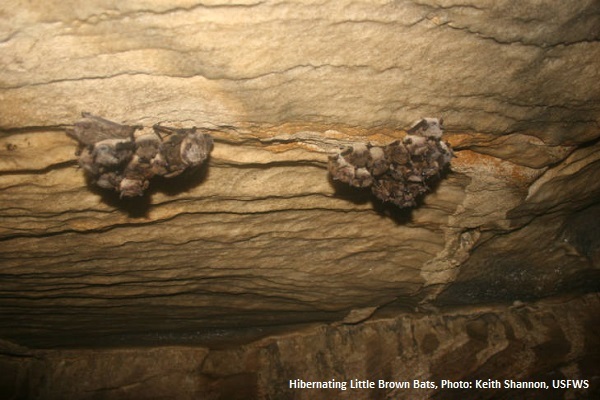|
October 25th, 2019
By the time National Bat Week rolls around, many of Iowa's bats are preparing to go into a deep sleep for the winter. This long period of inactivity, called hibernation, involves bats dropping their metabolic rate, heart rate, and body temperature, which in turn allows them to go long periods of time without food. All of the bat species in Iowa are insectivores, meaning insect eaters, so when winter comes and the flying insects they prefer disappear, bats either need to hibernate or fly to warmer climes.
 Different species of bats go about hibernation a little differently – not all species hibernate alike! The little brown bat (Myotis lucifugus) for instance, can hibernate for more than six months, while other species, such as the big brown bat (Eptesicus fuscus), are known to come out of hibernation if the location becomes too cold and move to a warmer location. The places where bats hibernate are called hibernacula. The preferred hibernacula for all of Iowa’s hibernating species, little brown bats, big brown bats, northern long-eared bats (Myotis septentrionalis), and tri-colored bats (Perimyotis subflavus), are caves and mines in eastern Iowa where it is humid and they can keep out of the freezing temps plaguing those of us above ground. All of these species are known to hibernate in caves together, solitary or in clusters, and the big brown bat specifically has been known to hibernate in clusters of several hundred!


The other five bat species found in Iowa during the summer, are migratory, and are usually headed out of Iowa by the time Bat Week rolls around. These species include the silver-haired bat (Lasionycteris noctivagans), hoary bat (Aeorestes cinereus), evening bat (Nycticeius humeralis), Indiana bat (Myotis sodalist), and Eastern red bat (Lasiurus borealis). There are some records of the Indiana bat hibernating in eastern Iowa, most notably Dubuque County and along the Mississippi River.
|
One threat to hibernating bats is white-nose syndrome (WNS). Considered one of the worst wildlife diseases of modern times, white-nose syndrome is caused by a fungus that affects hibernating bats and causes them to become more active and use up the fat stores they need to survive the winter without insects. It is especially devastating to bat species which hibernate in colonies (like little brown and northern long-eared bats) usually in caves and sometimes abandoned buildings. Big brown bats appear to have some resistance to the disease. Although WNS is most frequently spread through bat to bat contact, it can be spread by humans when the fungus gets on any clothing, footwear, or gear. This causes the disease to spread farther and faster than it otherwise would. In order to prevent the spread of WNS avoid any contact with any potentially affected sites, equipment, or bats themselves. Makes sure to clean and disinfect your clothing, footwear, or gear before entering any caves or known bat habitat.
 |
What can you do to help protect bats?
The best thing you can do to protect bats is maintain and increase healthy forests with an open canopy structure. Bats will use forests of all shapes and sizes from rural forest fragments to small city parks. To attract them to your yard buy or build a bat house and then benefit from the natural mosquito control! There are also opportunities to volunteer as a citizen scientist to help monitor bats. Fill out the Volunteer Interest Form at www.iowadnr.gov/vwmp/.
To learn more about the bats of Iowa, download the Iowa Bats infographic.
|